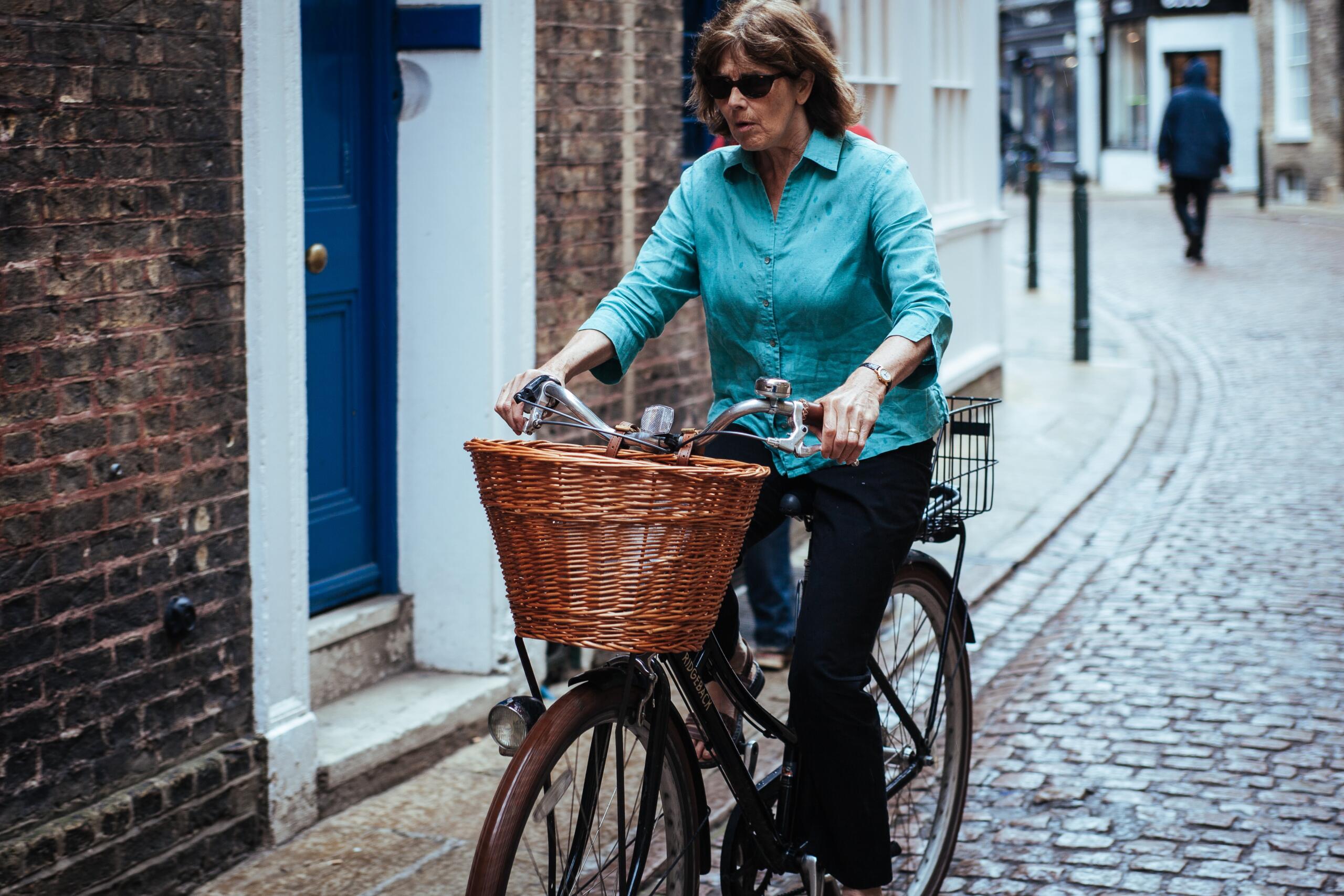Minds matter!
Mental health conditions that affect cognitive and communication skills can prevent travel — and an inability to use transport, or an absence of transport, can have a profound effect on how connected we feel.
Mental health and travel have a complex relationship. We have come a long way in the UK – and across Europe – in our discussions surrounding mental health. What was once an overlooked – even shunned – topic, is now spoken about far more widely.

Parent and a child cycling in a park.
Credit: Yiwen / Unsplash
Mental health difficulties are not uncommon. According to UK mental health charity Mind, 1 in 4 people will experience a mental health problem of some kind each year in England. For context, this means that on any given week in England, 8 in 100 people experience anxiety or depression, 1 in 100 people are affected by Obsessive-compulsive disorder (OCD), and 4 in 100 people experience Post Traumatic Stress Disorder (PTSD).
Mental health has a huge impact on an individual’s ability and willingness to travel, and travel can also exacerbate mental illness if stress and anxiety are experienced during the journey. But transport is also a means of providing a social connection that can help to alleviate some mental health conditions.
Sustrans and their partners in the UK have been exploring the connection between our transport systems and mental health, and the role active travel plays in supporting mental well-being.
This is core to Sustrans’ mission. Sustrans is the leading UK-based charity enabling people to travel by walking, wheeling or cycling for more of the journeys that are made every day.
From individual families to policymakers, the POLIS associate member works across the board to make active travel accessible, affordable, and enjoyable! Indeed, their work on gender equality, and young, and older age travel, has opened up conversations about what a Just Transition to sustainable urban mobility really means and how we can get there.
Addressing mental health and transport
‘Disability’ is a broad term covering a wide spectrum of physical, sensory, or mental conditions (sometimes apparent, sometimes more concealed) experienced in multiple ways. These conditions shape how individuals — and caregivers — navigate urban mobility services.
While cities have come a long way in considering how transport infrastructure can accommodate a spectrum of user needs, there is much work left to do.
It is more than simply adding ramps and elevators or widening cycle paths. Here, mental health must also be considered if we are to truly account for the spectrum of user needs across our transport systems.
To help us consider the way forward, Sustrans examines two studies which have shaped the organisation’s own thinking:
- A survey investigating the links between mental health and travel by Professor Roger Mackett, University College London
- A systematic review of the link between transport and loneliness by Dr Andrew Williams and colleagues, University of St. Andrews
The link between mental health and travel
We use a wide range of cognitive skills when we travel. These skills include concentration, interpretation of information, confidence in decision-making, interaction with other people, comprehension, and memory. Any condition that compromises these skills can impact our ability to travel.
Professor Mackett’s survey revealed the remarkable extent to which people reporting mental health conditions identify substantial barriers to travel – 89% of the survey respondents sometimes could not leave home at all because of their mental health condition.
These include:
- Car driving – 30% of people report mental health conditions causing substantial barriers to driving;
- Public transport – 20% to 36% of people with mental health conditions report barriers to different public transport modes;
- Cycling – 17% of people with mental health conditions reported that they are not able to cycle due to their mental health condition;
- Walking – 10% of people with mental health conditions reported that they find walking trips difficult due to their mental health condition.
This data emphasises the importance of walking and cycling as an alternative to driving a car or using public transport; however — and perhaps most importantly — it highlights the need for mitigation against some of the anxieties around navigation, anti-social behaviour, and access to facilities, which many experienced using these modes.
What solutions are at hand?
Navigability can be improved by providing frequent signposts to landmarks or other reference points, including street maps as a regular part of route signage, designing streets and paths to include a variety (so that places are distinctive enough to be easily recognised), and testing wayfinding infrastructure with a range of user groups.
We can improve the confidence of travellers by offering mentored rides and travel buddies for commutes, creating ‘safe places’ along routes where people can seek support and working with public transport to train staff to provide assistance. Meanwhile, improving the provision and visibility of public toilets will also go a long way to tackle travel anxieties.
At the same time, public awareness of the invisibility of many disabilities is needed. Campaigns such as the Department for Transport’s 'It's everyone's journey' campaign have helped to raise awareness of non-visible disabilities.
However, this must be a collective, co-created effort. Sustrans is increasingly looking to improve the ways it co-designs and co-creates spaces with people who have a mental health condition, as well as looking to partner further with mental health support organisations to steer this work.
The link between transport and loneliness
Loneliness has a major impact on our mental health. Millions of people across Europe struggle with feelings of loneliness, and transport plays a key role in mitigating and exacerbating this.

Woman cycling in Cambridge.
Credit: Clem Onojeghuo / Unsplash
Transport-related social exclusion — in which limited access to transport or other issues with the transport system prevents people from fully participating in society in the way they would like — has long been recognised. Yet, it has been a topic which has gone ignored — even deemed taboo. However, the COVID-19 pandemic has done much to reverse this; with widespread research in the US and Europe revealing loneliness was increasing, it came to the fore in the public debate, too. Little wonder, given one-third of people, reported feeling extreme loneliness!
Indeed, the UK government recently allocated £5 million for pilot projects to understand how transport can be used to alleviate loneliness. Yet, more can be done to address this.
'Walking, cycling and wheeling are foundational to confronting our mobility challenges, but we need to create the conditions required to encourage people to do so,' said Xavier Brice, CEO of Sustrans, speaking at POLIS’ Leadership Summit in Glasgow earlier this year.
Dr Williams' study, funded by Sustrans and Transport Scotland, looks in detail at the connection between transport and loneliness and isolation. For most of us, our social lives depend heavily on getting to places where we can interact with our friends and family members. This could mean going to cafes, bars, parks or other social spaces or simply getting out and about in our local communities.
Without the ability to make these connections, we risk becoming isolated, and we fear becoming lonely. The pandemic highlighted the vulnerability of some aspects of our social connections and has emphasised some of the factors that can lead to loneliness and isolation. How we get around has a fundamental effect on these social connections.
Sustrans conducted a review of a range of studies, which identified associations between private transport, public transport, community transport, active travel, transport infrastructure, and feelings of loneliness. It was also found that these associations vary across the life course and circumstances of individuals.
What is the role of transport?
1. Transport as a means of reaching destinations where you meet with other people
Ceasing driving due to age, illness, or a change in life circumstances such as becoming a parent can mean that people who did not previously need to use public transport suddenly find themselves needing to use it to avoid feeling lonely. According to one study, people who stopped driving also reduced their social activities, as they viewed arranging travel as an extravagance compared to travelling to shops or appointments.
In the absence of a car, public and community transport (including subsidised bus passes) become more important. Several studies document reduced feelings of loneliness among older people who use public transport more regularly.
Similarly, when there was inadequate public or community transport, studies documented greater feelings of loneliness.
The association between transport and loneliness in older age has been consistently documented. For some older people, the fear of loneliness was sufficient for them to continue driving against advice, prompting the urgency for reliable and accessible alternatives to the car.
This demonstrates a need for public and community transport and active travel routes that connect neighbourhoods and not just services or workplaces.
2. Transport as a space for meeting other people
Some papers discussed modes of travel as social spaces in which we meet other people. Cycling was associated with reduced feelings of loneliness, noting that walkers and cyclists met more people and felt greater social cohesion than car drivers.
However, it must be noted that sociocultural and environmental differences determined the extent to which active travel was able to offer this, particularly whether it is considered socially acceptable to interact with strangers in these situations.
3. Travelling alone as a contribution to welfare
Studies also acknowledge that travelling alone can also be beneficial for mental health and well-being, providing individuals with time and space for reflection despite the busyness of work or school.

Sustrans CEO, Xavier Brice, joins
the POLIS Glasgow Leadership Summit.
Credit: Glasgow City Council
Putting our best foot (and wheel) forward: Recommendations from the research
- Interventions are needed to support people in phases of life when driving is not an option, such as older age and single parents. Even when transport options are available, these groups may need support accessing them such as bus passes, low-level buses or easy-to-read timetables.
- Public and community transport and active travel routes need to support people reaching friends and family, not just places of work or retail.
- Some people value opportunities to connect while travelling, while others appreciate the time to disconnect. Modes of travel and transport policy should therefore consider both of these desires.
- Transport policy and interventions should consider all road users not just drivers, with the assessment of loneliness or social connections.
What should the transport sector take from these studies?
There is such a wealth of new information revealed by these two studies. None of these issues is ‘new’, yet the lack of attention they have been given across our transport and urban planning conversations reveals that we must continue to highlight them.
For an organisation like Sustrans, working with partners to deliver solutions that enable greater participation in active travel, we too have much to learn - from the concept, design, and delivery of our paths, cycle lanes and stations.
If we can get it right, we can make our cities work for everybody.
Click here to read the article in its original format.
About the authors
Dr Andrew Williams is a Senior Lecturer in Public Health in the Division of Population and Behavioural Science of the School of Medicine at St. Andrews. Andrew undertakes research with communities, children and adolescents about the social, cultural and environmental building blocks of health.
Andy Cope is Director of Evidence and Insight at Sustrans. Expert in research, evaluation and monitoring of active travel, Andy's work focuses on getting the best value from the evidence about the effectiveness of the work that Sustrans and others deliver in support of walking and cycling. Andy’s key skill is the ability to translate research and data to support the development of policy and practice.
Roger Mackett retired recently from his post at University College London, where he was Professor of Transport Studies for several years. His recent research has examined how having a mental health condition, such as anxiety or depression, can affect the way we travel.
Ruth van Ry is Evaluation Manager at Sustrans. Ruth manages a portfolio of evaluation and research projects in Northern Ireland, Scotland, and the Republic of Ireland.
